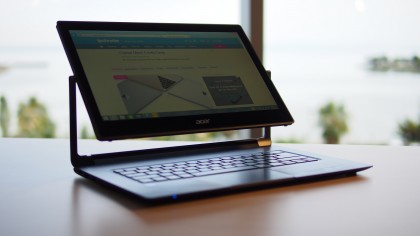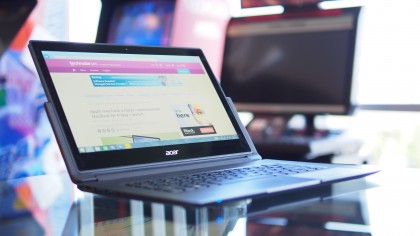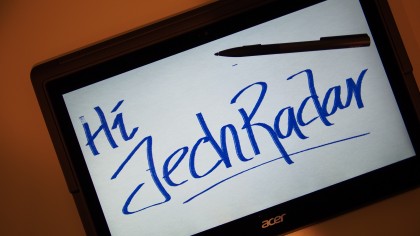Why you can trust TechRadar
If you're looking for a stylish Ultrabook that will grow with you, the base $899 (£610, AU$1,170) configuration for the Aspire R13 probably represents the best value. At that price, the Aspire R13 will compete with notebooks with a traditional clamshell form factor, like the $1,299 (£885, AU$1,690) configuration of the Dell XPS 13 with its bezel-less infinity display, $1,149 (£780, AU$1,495) Lenovo Yoga 3 Pro, and the $999 (£680, AU$1,300) Apple MacBook Air with a 13-inch display.
The main difference between the Aspire R13 and more traditional notebooks is that it can readily convert into a tablet - among other form factors - so you don't need to travel with both a laptop and a tablet.
Here's how the unit sent to TechRadar for review was configured:
Spec sheet
- Processor: 2.4GHz dual-core Intel Core i7-5500U
- Graphics: Intel HD 5000 with shared memory
- Memory: 8GB RAM (DDR3L, 1,600Mhz)
- Storage: 256GB SSD
- Screen: 13.3-inch WQHD, 2,560 x 1,440 touchscreen
- Camera: 720p webcam
- Wireless: Bluetooth 4.0; 802.11ac (B/G/N), dual-band Wi-Fi
- Ports: HDMI, 2x USB 3.0 (one always-on charging port), 1x USB 2.0, memory card reader, 3.5mm combo jack
- Battery: Four-cell
- OS: Windows 8.1
As configured, our review unit has a suggested retail price of $1,299 (£885, AU$1,690). Upgrading the solid state drive to a 512GB capacity will give you the priciest configuration for the Aspire R13 series, bringing the cost to $1,499 (£1,020, AU$1,950). The entry-level configuration ships with a dual-core Broadwell Core i5 processor with integrated Intel HD 5500 graphics, 8GB RAM, 128GB SSD, and a 13.3-inch full HD resolution touchscreen.
Usage modes
With six usage modes, the Aspire R13 also improves on the design of the Aspire R7. Rather than having the touchpad above the keyboard deck, the Aspire R13 reverts to a more traditional design with the trackpad below the keyboard deck. Not only is this more familiar, but with the screen tilted and angled in "Ezel," or easel, mode, the display no longer covers the touchpad.

In the more traditional notebook mode, I found that the Aspire R13 is comfortable to use, despite its larger footprint than a traditional notebook with the same screen size. The WQHD resolution display is a joy to use.
In notebook mode, just tilting the screen using the side hinges will engage the Ezel mode. The result is similar to an artist's ease. This mode still provides access to the keyboard and touchpad, but brings the screen closer to the user.

Stand mode is similar to Ezel mode, but gives the screen a lower profile. This mode is similar to opening the kickstand to its wider settings on the Surface Pro 3, and provides for an angled canvas, similar to what digital artists have with a Wacom Cintiq tablet. When used with the optional Active Stylus, stand mode provides for a comfortable position to sketch and draw.
I prefer the hinge mechanism on the Surface Pro 3 over the Ezel hinge on the Aspire R13 when using either the Ezel mode or stand mode. The Surface Pro 3 has a stiffer hinge that makes it harder to accidentally tilt the screen when pressure is applied, a trait that's useful when resting my hand or palm on the screen when using a digital stylus for inking or drawing.

Pad mode converts the notebook into a tablet. Given the heavier 3.31-pound weight of the Aspire R13 over the 1.75-pound (0.79kg) Surface Pro 3 without the keyboard or a 0.96-pound (0.44kg) iPad Air 2, I found myself not using pad mode all too often.
In the kitchen, when cooking, I prefer using the Epicurious Windows app and tent mode. This mode keeps the keyboard away from the hazards of the kitchen - like splashes of water, liquids and flour.
The last mode, display mode, will probably be used most by students and business professionals. For students, it brings the screen forward and hides the keyboard, giving a clear view for movies, photos, and media. For business users, the mode is great for small, casual presentations.
Current page: Specifications and usage modes
Prev Page Introduction and design Next Page Performance and benchmarks